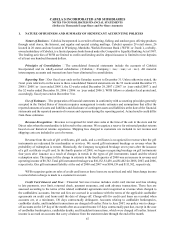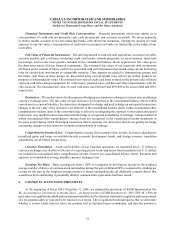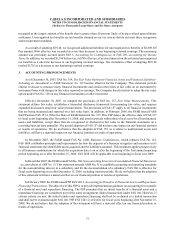Cabela's 2008 Annual Report Download - page 77
Download and view the complete annual report
Please find page 77 of the 2008 Cabela's annual report below. You can navigate through the pages in the report by either clicking on the pages listed below, or by using the keyword search tool below to find specific information within the annual report.72
CABELA’S INCORPORATED AND SUBSIDIARIES
NOTES TO CONSOLIDATED FINANCIAL STATEMENTS
(Dollars in Thousands Except Share and Per Share Amounts)
Financial Instruments and Credit Risk Concentrations – Financial instruments which may subject us to
concentrations of credit risk are primarily cash, cash investments, and accounts receivable. We invest primarily
in money market accounts or tax-free municipal bonds, with short-term maturities, limiting the amount of credit
exposure to any one entity. Concentrations of credit risk on accounts receivable are limited due to the nature of our
receivables.
Fair Value of Financial Instruments – The carrying amount of cash and cash equivalents, accounts receivable,
accounts payable, gift certificates (including credit card loyalty rewards programs), accrued expenses, short-term
borrowings, and income taxes payable included in the consolidated balance sheets approximate fair value given
the short-term nature of these financial instruments. The estimated fair values of our long-term debt instruments
are based on the amount of future cash flows associated with each instrument discounted using current borrowing
rates for similar debt instruments of comparable maturity. Time deposits are pooled in homogeneous groups, and
the future cash flows of those groups are discounted using current market rates offered for similar products for
purposes of estimating fair value. The estimated fair value of credit card loans is based on the present value of future
expected cash flows using assumptions for credit losses, payment rates, and discount rates commensurate with the
risks involved. The estimated fair value of credit card loans was $168,429 and $191,893 at the end of 2008 and 2007,
respectively.
Derivatives – We use derivatives for the purpose of hedging our exposure to changes in interest rates and foreign
currency exchange rates. The fair value of each derivative is recognized in the consolidated balance sheets within
current assets or current liabilities. For derivatives designated as a hedge and used to hedge an anticipated transaction,
changes in the fair value of the derivatives are deferred in the consolidated balance sheets within accumulated other
comprehensive income (loss) to the extent the hedge is effective in mitigating the exposure to the related anticipated
transaction. Any ineffectiveness associated with the hedge is recognized immediately in earnings. Amounts deferred
within accumulated other comprehensive income (loss) are recognized in the consolidated income statements in
the same period during which the hedged transaction affects earnings. For derivatives that do not qualify for hedge
accounting, changes in fair values are recognized immediately in earnings.
Comprehensive Income (Loss) – Comprehensive income (loss) consists of net income, derivative adjustments,
unrealized gains and losses on available-for-sale economic development bonds, and foreign currency translation
adjustments, net of related income taxes.
Currency Translation – Assets and liabilities of our Canadian operations are translated into U. S. dollars at
currency exchange rates in effect at the end of a reporting period. Gains and losses from translation into U. S. dollars
are included in accumulated other comprehensive income (loss) in our consolidated balance sheets. Revenues and
expenses are translated at average monthly currency exchange rates.
Earnings Per Share – Basic earnings per share (“EPS”) is computed by dividing net income by the weighted
average number of shares of common stock outstanding during the period. Diluted EPS is computed by dividing net
income by the sum of the weighted average number of shares outstanding plus all additional common shares that
would have been outstanding if potentially dilutive common share equivalents had been issued.
2. CHANGE IN ACCOUNTING PRINCIPLES
At the beginning of fiscal 2007, December 31, 2006, we adopted the provisions of FASB Interpretation No.
48, Accounting for Uncertainty in Income Taxes – an Interpretation of FASB Statement No. 109 (“FIN 48”). FIN 48
prescribes a recognition threshold and measurement attribute for the financial statement recognition and measurement
of a tax position taken or expected to be taken in a tax return. The recognition threshold requires that we determine
whether it is more likely than not that a tax position will be sustained upon examination, and then the position is
























